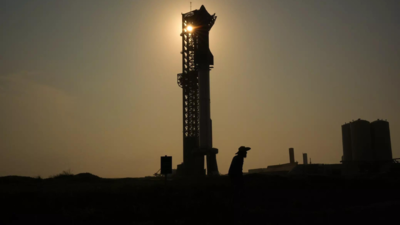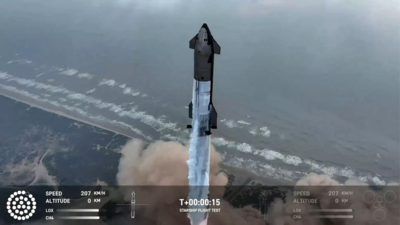
Robert Opal walks past SpaceX's mega rocket Starship as it is prepared for a test flight from Starbase in Boca Chica, Texas (AP photo)
NEW DELHI:
SpaceX
's colossal
Starship
rocket concluded its inaugural comprehensive
test flight
on Thursday, touching down on Earth intact following a successful launch from Texas.
The rocket's three prior test flights culminated in fiery explosions of both the rocket and spacecraft. However, this time, the two components managed to land in a controlled manner.
Towering at nearly 400 feet (121 metres), the world's most massive and potent rocket took off without any payload, soaring over the Gulf of Mexico as it charted a course towards the
Indian Ocean
.
Shortly after the morning launch on Thursday, the first-stage booster detached from the spacecraft and successfully splashed down in the gulf as intended, having completed its engine burn.
An hour later, live footage captured parts of the spacecraft disintegrating during the intense heat of reentry. Nevertheless, it remained sufficiently intact to continuously transmit data until reaching its designated splashdown location in the Indian Ocean.
"The main goal of this mission is to get much deeper into the atmosphere during reentry, ideally through max heating," Musk, CEO of SpaceX, wrote on social media on Saturday.
The rocket's first launch in April 2023 exploded minutes after liftoff, approximately 25 miles (40 km) above ground. During the subsequent attempt in November, Starship reached space for the first time but exploded shortly after. In its most recent flight in March, Starship traveled much farther but broke apart in Earth's atmosphere while attempting to return from space halfway around the globe.
The flight was a repetition of the previous test but with the goal of reaching a greater distance. The rocket's first stage, called Super Heavy, ignited its 33 Raptor engines to lift off and was expected to separate from the Starship second stage, which would then propel further into space. Super Heavy is anticipated to re-ignite some engines and return to the Gulf of Mexico for a "soft splash-down" to simulate a landing that would otherwise occur on land.
The rocket was equipped with hundreds of small black tiles designed to protect against the extreme heat encountered while diving through Earth's atmosphere at hypersonic speeds.
Nasa
is relying on SpaceX's development of Starship as it aims to return astronauts to the moon in 2026, competing with China, which plans to send its astronauts there by 2030. China has recently made several advancements in its lunar program, including a second landing on the moon's far side in a sample retrieval mission.
(With inputs from agencies)













 English (US) ·
English (US) ·